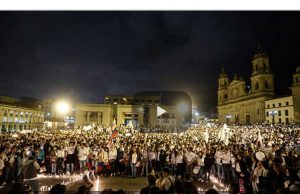. . DEMOCRATIC PARTICIPATION . .
An article Caracol TV (translation by CPNN)
Tens of thousands of people marched Wednesday [October 5] in at least 16 cities in Colombia demanding the government and the opposition to reach a peace agreement with the FARC, after the rejection of the agreement with the guerrillas in a plebiscite. In 12 cities, including Bogota, Barranquilla and Cali, citizens demanded that President Juan Manuel Santos, promoter of the peace pact with the FARC, and the former president Alvaro Uribe, a fierce opponent of the agreement, should work together to overcome the armed conflict that has hurt Colombia for over half a century.

video of march available on website of Caracol TV
“My heart is aching. Peace is not Uribe or Santos, peace is us. That makes me angry,” said Alejandro Quevedo, a math teacher of 31 years who attended the university rally in Bogota .
With white shirts and white flowers, at least 30,000 people participated in a silent march for peace in Bogota that ended in the central Plaza de Bolivar. They protested the results of the plebiscite on Sunday, where 50.21% of voters said “No” to the agreement with the Revolutionary Armed Forces of Colombia (FARC) after nearly four years of negotiations in Cuba.
Santos called for a national dialogue to seek alternatives. He met Wednesday with Uribe in the presidential palace, where he said he is determined to “seek ways of unity and reconciliation” to achieve peace.
“No more victims”
“For all that unites us and what separates us,” read the poster that led the march, carried out in absolute silence with the flames of white candles, the colored flags of Colombia and the gay community. Only a few marchers raised their fists.
“I march with uncertainty in the face of the silence and lack of will to solve things of those who voted ‘No’, I feel that is all I can do now to try to find solutions,” said Lina Vanegas, a university teacher of 29 years present at the demonstration.
Silently holding candles, some government officials also participated, for example, Interior Minister, Juan Fernando Cristo, and senior advisor for post-conflict Rafael Pardo.
(Article continued in the right column)
(Click here for the original version of this article in Spanish.
What is happening in Colombia, Is peace possible?
How effective are mass protest marches?
(Article continued from the left column)
But the silence of the march was broken when the audience sang the national anthem. That gave way to shouting slogans like “We want peace”, “No more war”, “No more victims” and “Not one step back” as marchers formed the symbol of peace with their candles.
Protesters then read the “Prayer for Peace”, a speech of the assassinated liberal leader Jorge Eliecer Gaitan, who in February 1948 led protests by 100,000 people in the capital against political persecution by the conservative government of Mariano Ospina Perez.
“Stop the violence, Mr. President. We simply ask for the defense of human life, which is the least a people can ask”, cried Gaitan, a few months before he was killed.
It is “necessary” to stop the hate
In Barranquilla and Cali, dozens of citizens dressed in white also demanded an end to the internal conflagration and an extension of the bilateral cease fire respected by FARC since August and extended by Santos until 31 October.
“People who have actually lived through the war itself are those who want change, they want a transformation (…) and that was not shown in the plebiscite,” said Stefany Vergara a literature student 28 years of the Universidad del Valle in Cali, where about 4,000 people marched.
The FARC, meanwhile, supported with tweets on what they called “#PazALaCalle”. “They will maintain peace and willingness to use only words as weapons for future construction. Peace will triumph,” they said.
The call for demonstrations went beyond the borders of Colombia. In New York, some 50 Colombians gathered in Times Square, the heart of Manhattan, to sing “Colombia wants peace!” and advocate for the end of the continent’s oldest armed conflict.
“Civil society has begun to mobilize to tell the government that we do not want a renegotiation but the accords that are already done,” said the painter Ricardo Prado, 25, in the Times Square gathering
Mobilizations of Colombians calling for an end to the war also took place in cities of Holland, England, Dominican Republic, Ecuador and France.
The armed conflict in Colombia for more than 50 years involving guerrillas, paramilitaries and government forces, killing some 260,000 dead, 45,000 missing and 6.9 million displaced.